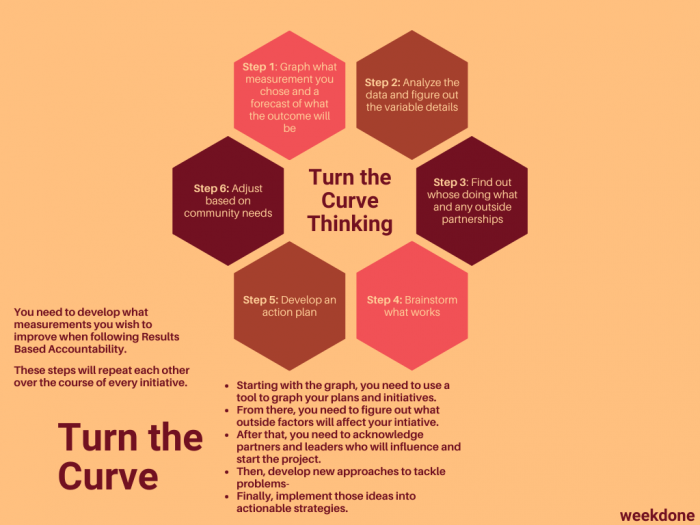Results Based Accountability (RBA) involves intense self-discipline in order to improve problems within a community. This is done by changing how you think and act. Results Based Accountability is primarily used in the public sector and in community projects to improve the lives of specific community members. Whether the focus is on the community as a whole, children, families, youth, or adults, Results Based Accountability increases the effectiveness of community efforts.
Results Based Accountability was coined by Mark Friedman in his book Trying Hard is Not Good Enough. Ever since he wrote on the subject, Results Based Accountability has been implemented in all 50 states and several other countries. The goal is to provide a measurable change from the individual level to larger communities and organizations.
Examples of RBA
The point of maintaining community impact is to focus on the conditions of any given group within a community by a group of leaders. The point is to create positive outcomes within a targeted group within the community.
Some examples include:
- Improving membership growth to improve health and utility
- Improving solution response rate so the community serves as a good support system
- Improve the number of people contributing to the community efforts to maintain community relevance
- Improving job quality and employment
It’s important to make sure these outcomes are measurable. These measurements are known as community indicators and these indicators are usually managed by public organizations.
Turning the Curve Thinking

Once you identify what you actually want to improve, you need to focus on the individual, measurable steps to achieve it. This process is typically called turning the curve. Download the infographic to remember the steps in the “Turn the Curve” thinking.
Why Use Results Based Accountability?
There are many reasons to use Results Based Accountability. That being said, here are the main benefits:
- Uses transparent communication and data to make sure that both community member and leaders are held accountable
- Helps communities work together
- Helps overcome typical leadership problems by allowing for creative thinking
- Is a simple, step-by-step process that everyone can understand
- Gets from ideas to implemented plans quickly
Results Based Accountability and Practicality
Results Based Accountability needs to be implemented and informed through practice. As a community, it’s important to draw from the subjective experiences of individual members instead of wholeheartedly structuring everything using RBA.
In this sense, Results Based Accountability serves as the representation of how you’re actually going to change things, and implementation is how you go about doing so. It’s like a performance. You can have the script, but the way it’s spoken will be a little different every time.
That’s why it’s incredibly important to remember to make adjustments to the RBA format to suit your community’s interests. Remember, Results Based Accountability gives you the ‘what’ and ‘how’ to make positive impacts possible, but you need to answer the rest of those questions using community feedback.
Why would your initiative benefit the community? Who is being represented and why? Where in specific are you going to apply your project? From there, you can start using Results Based Accountability and making fine-tune adjustments based on real-time feedback.
Use plans as resources for action
There’s a big leap from plans to actions in community efforts. The theory of Lucy Suchman (1987) can apply pretty well here. The idea is the distinction that plans are a concept to drive the action forward and not just the prequel to that action.
The reason accountability works, argues Suchman, is because plans should acknowledge information and skills that someone can act on right away. For example, by using a planning template and assigning tasks to individuals instead of teams or groups, you can highlight an individual’s skill that leads to action much faster.
How to measure
Making sure you properly take measurements ensures that you avoid a lack of control in your efforts. Being able to properly measure performance is how RBA works after all!
Some of the things most affected by lack of measurement include volunteer and employee turnover rates and staff morale. By claiming it’s outside your control, your community ultimately suffers and your leaders fail to deliver.
Something to note when measuring your performance in an initiative is that the more important it is, the less you will have immediate control over the outcome. So, for example, if your initiative is for children successful in the second grade, then a group of leaders will have very little control of variables.
Using Objectives and Key Results
Objectives and Key Results serve as a great methodology for measuring your Result Based Accountability efforts. Objectives stand for your committed or aspirational goals and Key Results serve as how you measure them.
Because of this, it makes sense to connect Key Results to RBA and implement Key Results as your metric for your community outreach goals while following the Turn the Curve steps.
Of course, the two work well together because Key Results can fail when dealing with situations where control is nearly impossible. That being said, OKRs serve as another framework to ground your community efforts and to make sure you take action on your plans.
3 Results Based Accountability Tools
1. Weekdone
Weekdone is a great tool for Results Based Accountability. It serves as an OKR tool which means that being measurable is an absolute requirement while getting used to the OKR system.

Weekdone’s features include:
- Weekly Planning along with OKRs for actionable plans
- Goal setting and management for both long and short term
- Project tracking and management for many teams
- Live Newsfeed
2. Zelos
Zelos is specifically designed for nonprofits and volunteer efforts. Because of this, it includes all the basic tools you need for managing a nonprofit.

Zelos’s features include:
- Importing and exporting data
- External integrations
- Task Scheduling/Tracking
- Calendar Management
3. Todoist

Todoist is primarily a task management app. Though you will need to use something else in order to set larger goals and measure the progress of bigger initiatives, todoist is great for encouraging immediate action.
Todoist offers features like:
- Recurring due dates
- Up to 80 active projects